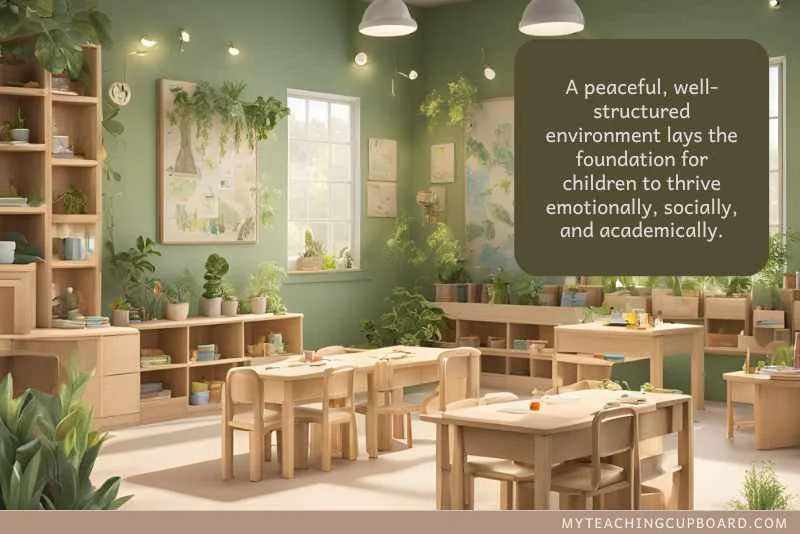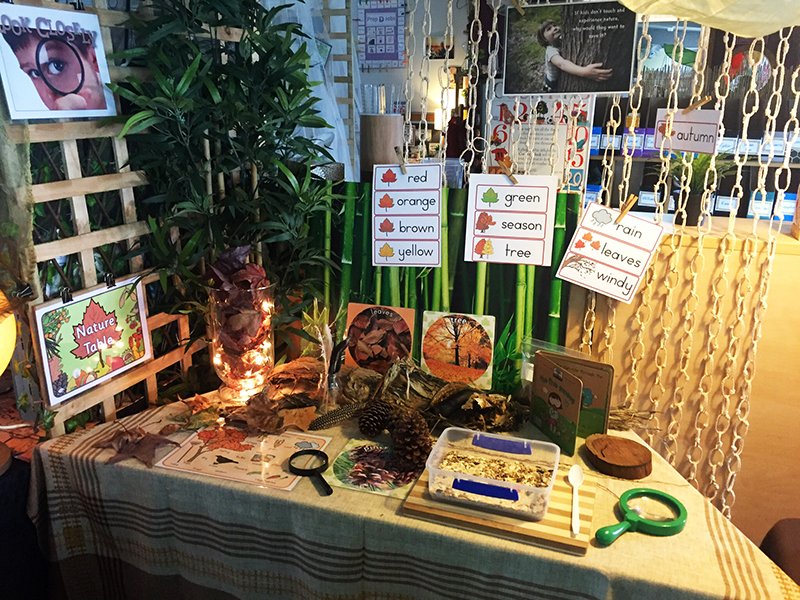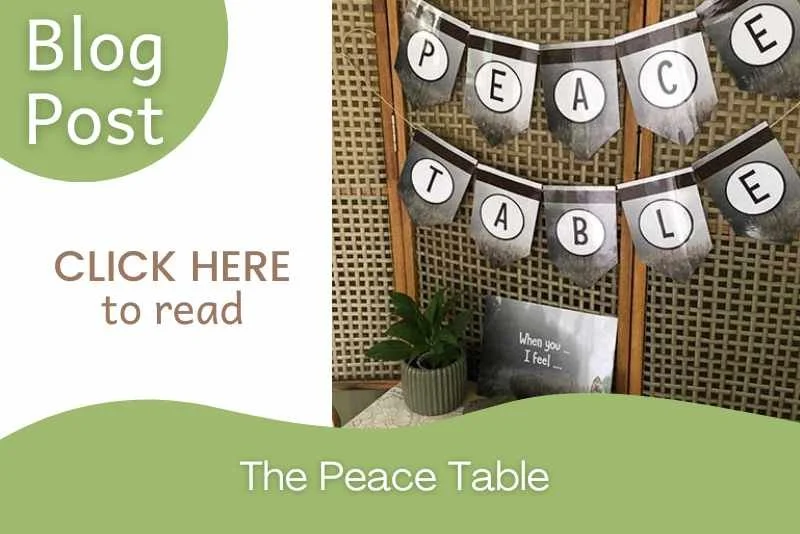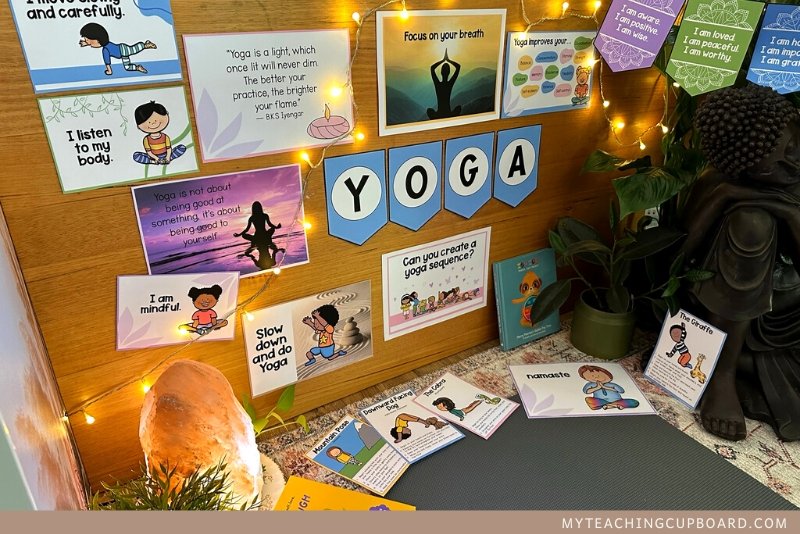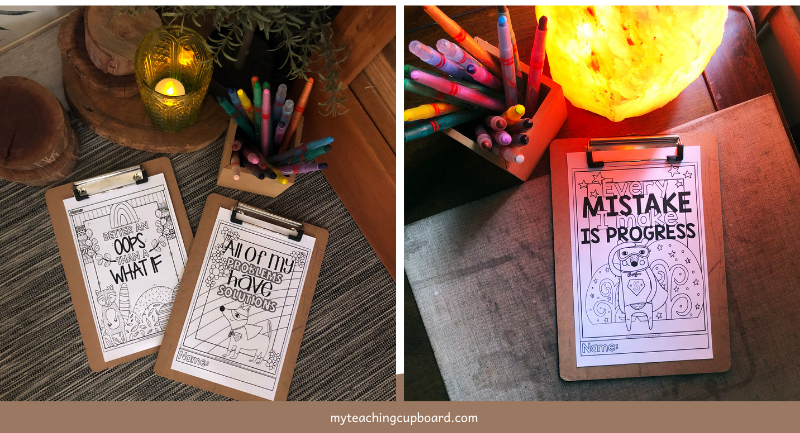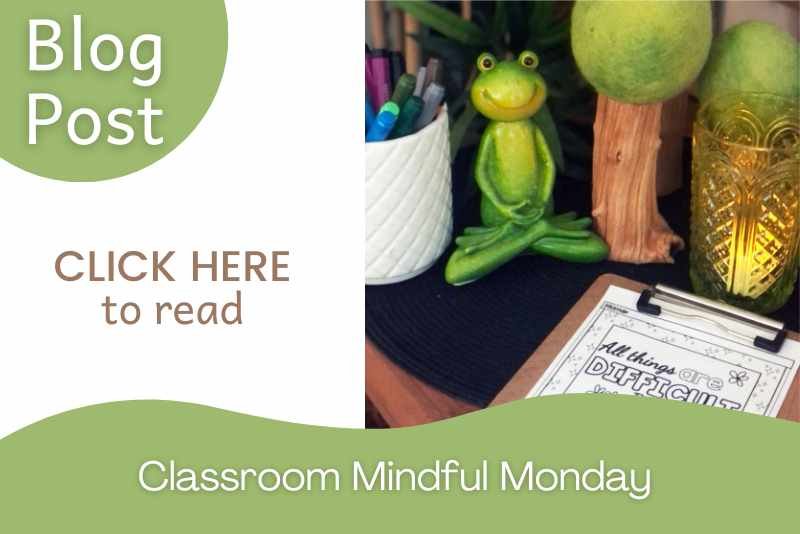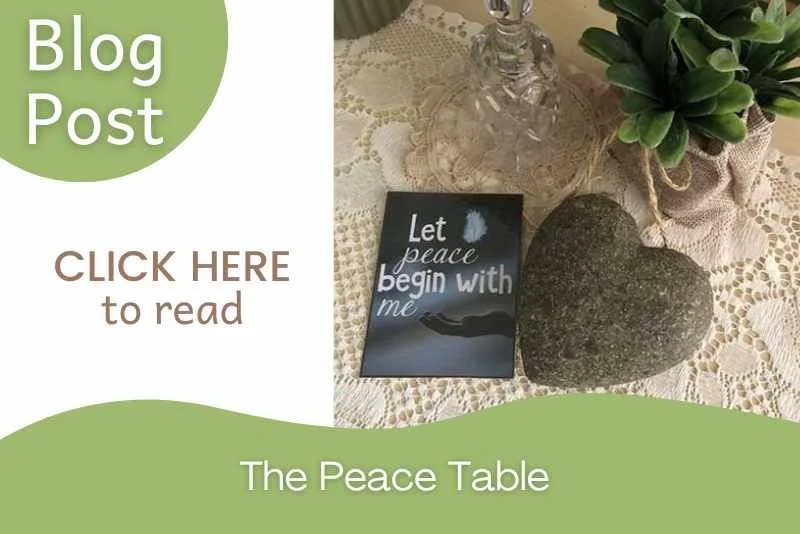Creating a Calm and Peaceful Classroom Learning Environment
Discover how to create a peaceful learning environment in your classroom with calming routines, mindful spaces, and practical resources. Reduce sensory overload, foster emotional growth, and promote student focus with my social and emotional learning tools and transform your classroom into a safe, calm space where students thrive.
As a teacher with years of experience, I can remember the excitement ( and occasional chaos) that filled my classroom in the early days. Like many of you, I was a fresh, enthusiastic teacher with many goals and aspirations for my new career.
I remember my classroom environment was a priority and I was determined to create a highly engaging learning environment.
When I look back over those early days of teaching, I realise so much has changed. Primarily, the behaviours and needs of today's students have changed significantly.
Today’s students, especially those with neurodivergent needs or past traumas, require a calm and safe space where they can thrive emotionally and academically.
Over the years, I have worked hard to perfect the art of creating a peaceful classroom where every child, including those with neurodivergent needs or past traumas, feels safe and at ease. I have learned there’s so much more to creating a calm and peaceful classroom than just having a quiet corner or calm-down routines.
It’s more about creating an atmosphere.
The reality is that many classrooms today are overstimulating.
Teachers and students often face a barrage of distractions—noisy activities, bright colours, cluttered spaces—and it's hard to maintain a sense of calm amid all the chaos.
Neurodivergent children, in particular, struggle to focus in such environments, and it's becoming more common to see students coming to school with high levels of stress or trauma too.
Are you struggling to create a peaceful learning environment in your classroom? Are you finding that your students are overstimulated or have trouble self-regulating?
The solution lies in transforming your classroom into a peaceful place where both you and your students can thrive. By making intentional changes—like
introducing a calming, nature-inspired peace table
using neutral décor
and creating quiet spaces for self-regulation
—you can cultivate an environment where your children feel safe, calm, and ready to learn.
I’ve found that with the right resources and strategies, it’s entirely possible to create a space that benefits both teachers and students alike.
The Importance of a Peaceful Learning Environment
The educational environment plays such an important role in shaping children’s learning experiences. One of my favourite educational theorists, Maria Montessori believed that children learn best in environments that offer freedom within boundaries, encouraging calmness and independence. She emphasised the role of a carefully prepared environment. One that is intentionally designed to promote peaceful exploration and learning.
Similarly, another favourite pedagogy - the Reggio Emilia approach, refers to the environment as the third teacher. This internationally renowned approach highlights the vital role the classroom environment plays in nurturing creativity, collaboration, and problem-solving skills.
Both theories agree: a peaceful, well-structured environment lays the foundation for children to thrive emotionally, socially, and academically.
Research also supports the idea that peaceful environments contribute to better behaviour and focus. The CAPSLE (Creating a Peaceful School Learning Environment) program demonstrates how fostering a calm atmosphere leads to improved classroom dynamics. CAPSLE’s approach focuses on equipping all students, including those who might traditionally be separated for special programs, with techniques to resolve conflicts non-physically.
By creating an inclusive environment where all students practice these techniques, schools have seen positive shifts in behaviour. One teacher in the program said, “I can finally teach again!” What an immense impact a peaceful environment can have on the teacher's ability to actually teach!!
Beyond behaviour management, a peaceful classroom also improves emotional regulation, focus, and cognitive functioning, particularly for neurodivergent students or those dealing with past traumas.
When the environment is calm and predictable, students are more likely to feel safe, leading to better focus and a greater capacity to retain information.
A chaotic or overstimulating classroom can have the opposite effect, heightening stress and making it difficult for students to regulate their emotions or engage in learning.
Statistics consistently show that well-organised, calm classrooms are linked to better academic outcomes.
According to research, students in classrooms with reduced sensory overload and clutter tend to perform better academically, showing higher engagement levels and fewer behavioural issues. This is particularly relevant in today's classrooms, where many students have complex needs and benefit from structured, calming environments.
To explore more about how your classroom environment can act as a “third teacher” and positively impact student learning, check out my blog post: Environment as the Third Teacher
Must-do’s for Creating a Peaceful Classroom
First, let's consider the physical space. There are three key design elements that you need to consider when creating a calm and peaceful classroom.
1. Declutter and Simplify Décor
A clutter-free classroom with simplified décor can dramatically reduce sensory overload and create a more calming and focused environment.
When students are surrounded by bright, overly stimulating visuals, it can lead to distraction and even anxiety. By opting for neutral tones and a minimalistic approach, you create a soothing space where students can concentrate better and feel more at ease.
Neutral colours, such as soft beiges, creams, and muted greys, help reduce the visual “noise” and provide a peaceful backdrop that doesn’t compete for students’ attention.
To achieve this, consider using my Neutral-Themed Play-Based Learning Area Signs and Banners.
These calming signs help keep your classroom centers organised and visually consistent, reducing sensory overload while still maintaining a beautiful, functional space. The neutral tones also create a unified aesthetic throughout your classroom, allowing for an inviting and predictable atmosphere where children learn without distractions.
2. Use of Nature and Natural Materials
Bringing nature inside and using natural materials in your classroom environment is another effective way to foster calmness.
Natural elements, like plants, wooden toys, and natural fabrics, can provide a connection to the outdoors and this has been shown to help reduce stress and promote emotional well-being.
Studies suggest that exposure to nature has a calming effect on children, helping them to regulate their emotions and stay focused during learning activities.
3. Lighting and Colour Choices
The lighting and colour choices you make in your classroom also play a significant role in creating a peaceful atmosphere. Research shows that soft, natural light is preferable for promoting relaxation and focus. Harsh fluorescent lighting can be overstimulating, while softer, warmer lighting options, such as natural daylight or lamps with dimmers, help create a calming space.
This is the light hanging above our Art table. We love the soft light it gives off. I made it by tying some hanging Christmas lights to a cane hoop.
In terms of colour, studies indicate that certain shades, particularly blues, greens, and neutral tones, are best for fostering a calm classroom environment.
Blues are known for their soothing qualities, helping to reduce tension and create a sense of tranquillity, while greens evoke feelings of nature and renewal, promoting a restorative environment. Neutral tones, like soft greys or beiges, provide a balanced background that is neither too stimulating nor too dull, supporting a peaceful learning atmosphere.
What is the best colour for a calm classroom?
Calming colours, such as soft blues, greens, and neutral tones, are the perfect colours for promoting a peaceful learning environment. These shades help students stay relaxed, focused, and more receptive to learning. They are ideal choices for a classroom setting.
Creating Calm Spaces for Self-Regulation
In my classroom, I use a Peace Table and classroom yoga to provide my students with the tools and spaces they need to develop self-regulation and mindfulness. They help to make our classroom a more peaceful, productive learning environment.
The Role of a Peace Table or Quiet Corner
In any classroom, especially one geared toward young children, having a dedicated space for self-regulation is essential. Enter – The Peace Table. This little gem of an idea has been borrowed from the Montessori classroom.
A Peace Table is a designated area where students can practice self-regulation, negotiate conflicts, and reflect on their emotions. This is a must-have space in my classroom. It’s such a great tool for young children who are still developing and refining the social and emotional skills needed to navigate disagreements and challenges.
This space allows children to step away from stressful situations, reflect on their feelings, and work through emotional challenges in a constructive way.
Being able to resolve a disagreement calmly is a crucial life skill that needs to be explicitly taught.
Peace education is a focus of mine at the start of every school year. I believe the skills we learn and the routines we put in place at the beginning of the year set us up for a successful school year. They help us build and maintain a safe environment and we all deserve a peaceful and safe learning environment.
The Peace Table builds positive relationships and offers a consistent and supportive framework that empowers students with the tools they need to manage conflicts independently.
You can learn more about setting up a Peace Table and its many benefits by visiting my blog post, The Peace Table.
One way to harness these benefits in your classroom is through the use of my Peace Table Display Packs, which feature calming, nature-inspired designs.
These packs include printable posters, illustrated quotes, and negotiation reminders that guide students through the process of calming down and resolving conflicts.
There’s even a guided PowerPoint lesson included to make introducing the Peace Table to your students easy and stress-free for you!
Say goodbye to being the classroom policeman and peacemaker and give your students the skills they need and the steps they need to take when they are upset or in disagreement with others.
Classroom Yoga and Mindfulness Areas
In addition to the Peace Table, creating a space dedicated to yoga and mindfulness will greatly benefit your students.
Yoga and mindfulness are my go-to relaxation techniques whenever classroom energy is running high.
These practices promote physical calmness and mental focus, allowing children to release tension and refocus their energy. I have found them to be especially beneficial for children who may struggle with sitting still or managing big emotions.
Setting up a Yoga and Mindfulness Area in your classroom doesn’t require much space and can have a significant impact.
I like to include soft mats, calming music, and visuals that guide students through basic yoga poses or breathing exercises.
Introducing students to yoga and mindfulness routines helps them
regulate their bodies
increase their focus
and promote a sense of calm.
To make it easy for you to set up this space, I have a lovely selection of Classroom Yoga Printables to help you. They include everything you need to create an inviting yoga area in your classroom.
I have printable posters that illustrate yoga poses, breathing techniques, and mindfulness practices. Calming, pastel-coloured visuals, banners, and inspirational quotes are also included to create a peaceful atmosphere for your students to learn and practice calming yoga and mindfulness activities.
For more tips and ideas on how to set up your very own classroom yoga space, check out my blog post: Create a Calm Corner for Yoga in the Classroom. This post will walk you through setting up an inviting, calming space where your students can practice yoga and mindfulness daily.
In my yoga and mindfulness areas, I also like to add a few sensory toys like fidget spinners, pop-its, and a stress ball.
Adding resources like these to your mindfulness corner can give students another method for calming their bodies and minds. Because these sensory tools can help some children manage anxiety or restlessness, I'll always add a few to cater to those children who need them.
Establishing Peaceful Classroom Routines and Procedures
Establishing routines and procedures with your students builds the foundation of a peaceful classroom. Predictable routines not only help students understand what is expected of them, but they also create a sense of security and calm.
When students know what to anticipate each day, it reduces anxiety and gives them the mental space to focus on learning. This has a flow-on effect, helping them interact positively with others.
A well-structured routine supports a peaceful learning environment where students feel safe, grounded, and ready to engage.
Consistent and Clear Expectations
Setting clear expectations and maintaining consistent routines are vital in helping students feel secure and at ease. I have found, that when children have clear rules, know the boundaries and are prepared for what comes next, they are more likely to stay focused, self-regulate, and contribute positively to the classroom dynamic.
Simple, calming routines like a morning or afternoon circle time or daily mindfulness exercises can create a peaceful rhythm to your school day.
One of my favourite calming routines is Mindful Monday, a routine my students absolutely adore. I like using Mindful Monday as a lovely way to ease into the school week. It creates an element of mindfulness and calm and sets us up for a good week right from the start.
Each Monday morning, before the doors open, I set up small intimate spaces around the room, each with a clipboard holding a mindful colouring sheet, tins filled with crayons and pencils, and tea-light candles placed in coloured glass jars.
The students love finding these little calm corners, and it sets a peaceful, mindful tone for the week ahead. This simple quiet time activity helps students start the day (and the week) feeling centred and calm.
If this sounds like a routine you would like to add to your classroom, you can read more about how to implement Mindful Monday in my blog post: Mindful Monday.
Conflict Resolution Strategies
Teaching children conflict resolution strategies is another essential part of establishing a peaceful classroom. Children often need guidance in navigating disagreements and managing their emotions when conflicts arise.
By explicitly teaching your students the steps they need to help them resolve conflicts (like taking turns to speak, using “I feel” statements, or finding a compromise), you are giving them lifelong skills that foster both social harmony and emotional intelligence.
Once again, I have found one of the best tools for teaching these skills is the Peace Table. As mentioned earlier, this designated space provides a space where children can practice self-regulation, reflect on their emotions, and work through conflicts calmly.
Part of introducing the Peace Table to your students is teaching them the strategies to use this space effectively. For a Peace Table to have the desired effect, you’ll need to empower your students to solve their disagreements non-aggressively by
using the correct language and negotiation prompt
using the tools like the peace bell and talking heart
and referencing the calming visuals and negotiation prompts provided.
Don’t worry if you are not sure how to set up a Peace Table or what conflict resolution strategies you need teach your students. Head over to this blog post: The Peace Table to discover how.
Not only does the Peace Table support a more peaceful classroom, but it also equips children with practical strategies for resolving conflicts they can use way beyond the school environment. Can you tell how much I love it?
The Role of Teacher Behaviour
While establishing routines and strategies for students is key, teachers also play an equally important role in modelling peaceful behaviour.
As a teacher, your calm, regulated presence sets the tone for the entire classroom. Children often mirror the behaviour of the adults around them, so by demonstrating calm responses to stress and conflict, you’ll be providing a powerful example for your students.
In addition to calmness, modelling mutual respect is essential.
When students see you treating others with kindness and respect, they learn to do the same. This creates a classroom culture where everyone feels valued and safe, reinforcing the peaceful atmosphere you're working to establish.
Simple techniques like
deep breathing
taking a moment to pause before reacting
and using mindfulness practices
can help teachers maintain a peaceful presence, even during stressful moments.
When you model these behaviours and mutual respect, your students will see that self-regulation and respectful interactions are skills everyone can practice.
By establishing consistent routines, teaching conflict resolution, and modelling calm and respectful behaviour, I know you can create a classroom environment where peace and focus naturally flourish.
Creating a Peaceful Classroom Environment: Small Changes for a Big Impact
At the end of the day, creating a peaceful learning environment leads to preferred behaviours, enhanced learning outcomes, and support for the overall well-being of your students.
As I’ve experienced in my own classroom, even small changes to our learning space - like introducing calming routines, incorporating natural elements, and setting up a Peace Table or a Yoga area, can make a significant impact.
These easy-to-do adjustments help students feel more secure, reduce sensory overload, and empower them with essential skills for managing their emotions and interactions.
If you’re looking for ways to start creating a more peaceful environment in your own classroom, I encourage you to explore my range of social and emotional learning resources.
From tools for developing listening skills to resources focused on emotions, feelings, yoga, and mindfulness, these carefully designed materials will help you build a calmer, more focused classroom.
Say goodbye to an overstimulated classroom where students have trouble self-regulating and staying focused and make a few adjustments to start transforming your classroom into a peaceful place where both you and your students can thrive.
Check out all my social and emotional learning resources and begin your journey to a peaceful learning environment today.


